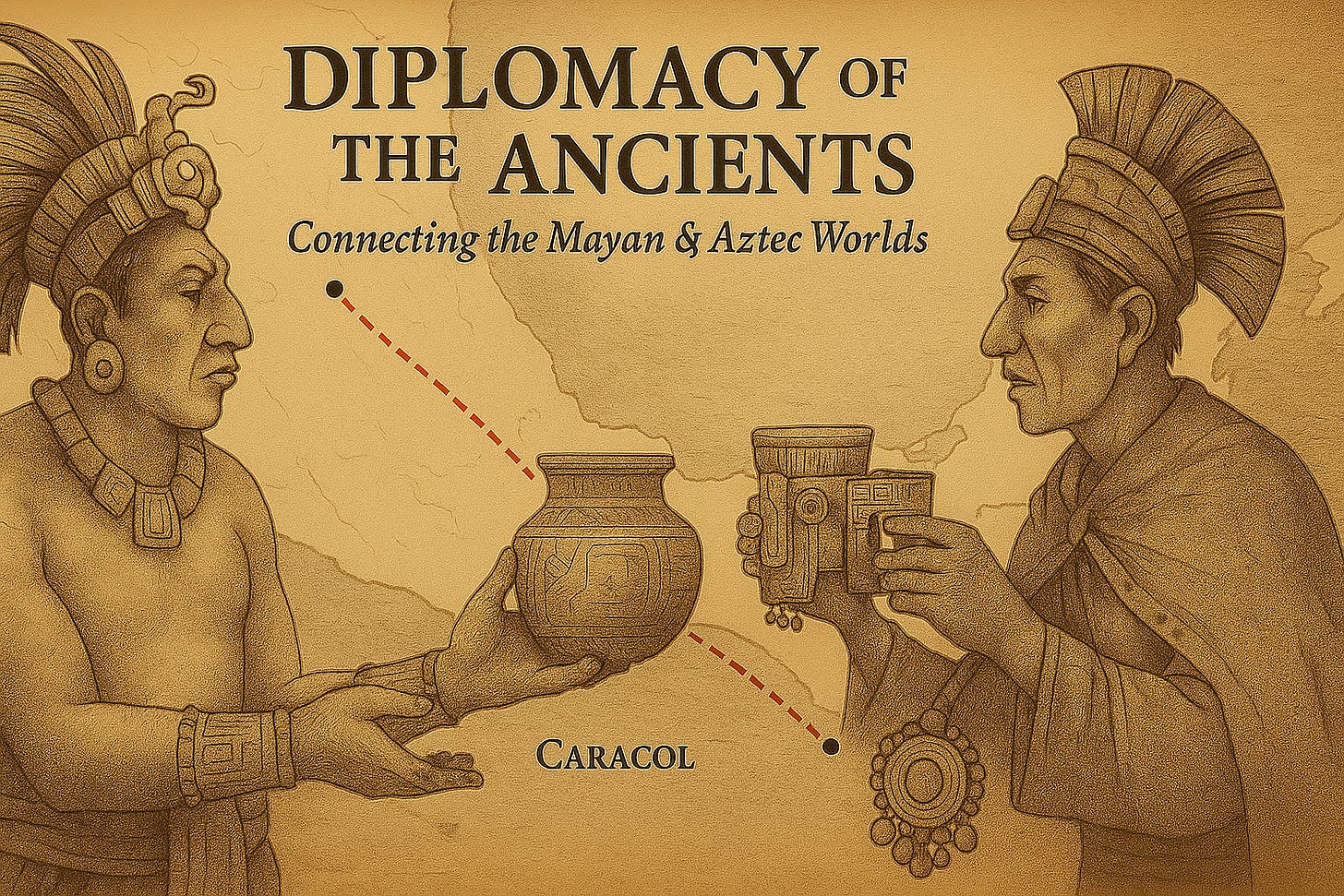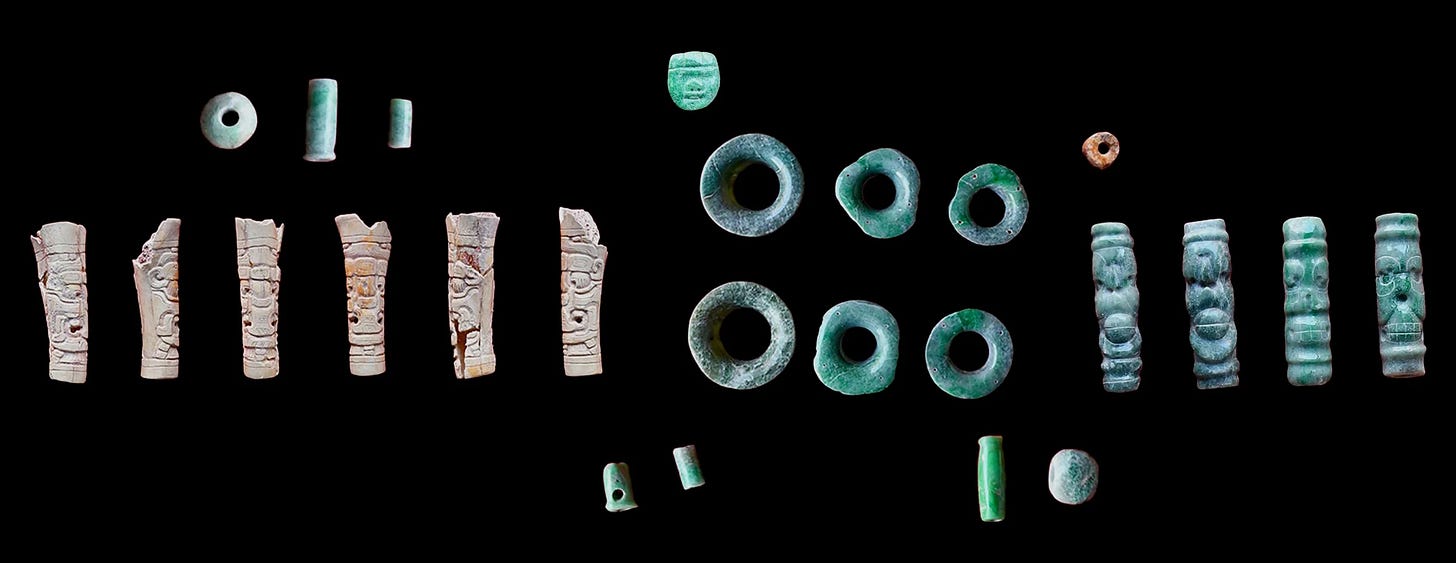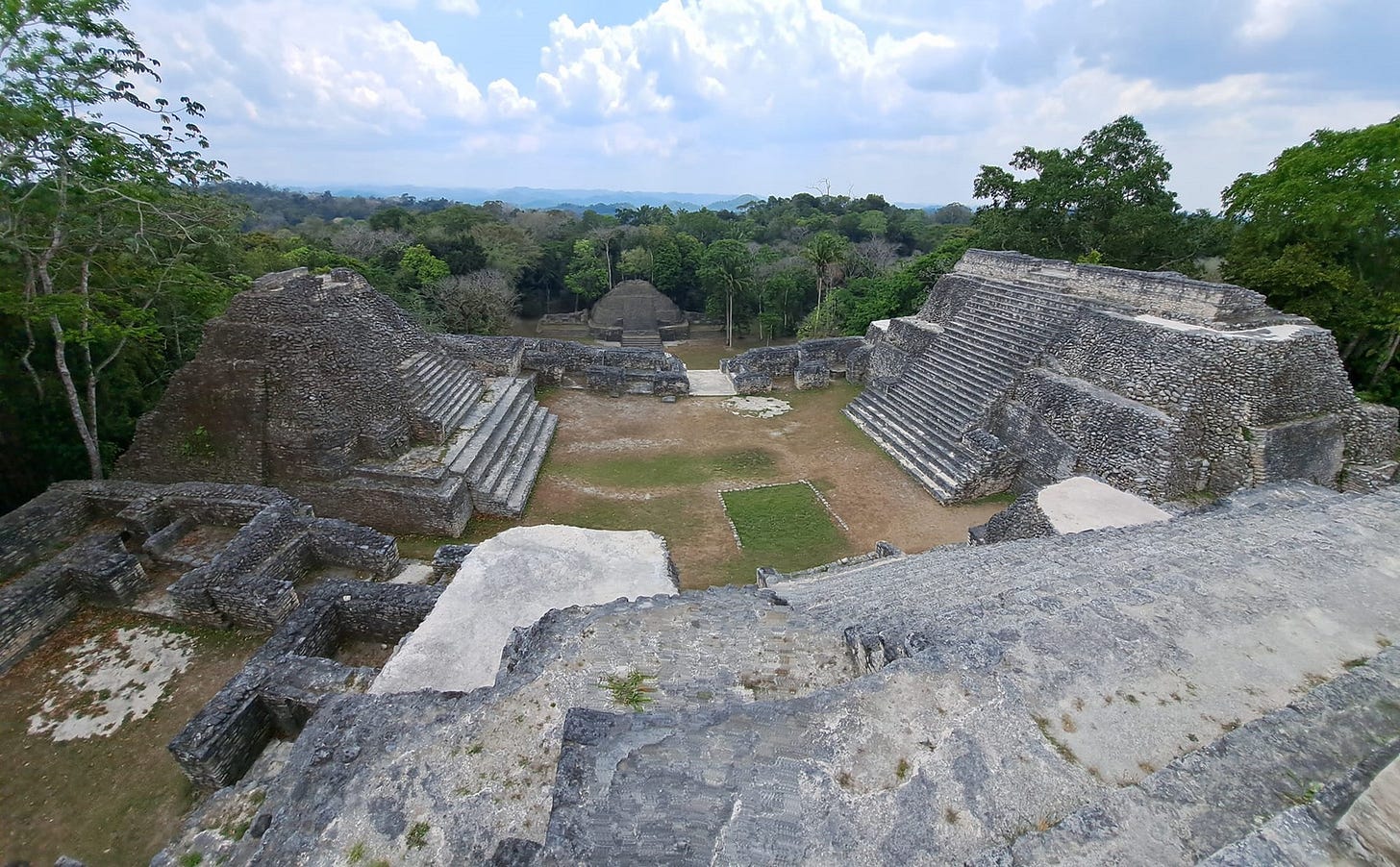🏺 Ancient Secrets Revealed: 1,700-Year-Old Maya King's Tomb Discovered in Belize
Revolutionary find proves ancient Maya rulers had formal diplomatic ties with Mexican metropolis centuries earlier than believed
😽 Keepin’ It Simple Summary for Younger Readers
👧🏾✊🏾👦🏾
🌟 Imagine digging in your backyard for 40 years and finally finding the ultimate treasure chest. 🤯 That's essentially what happened to two archaeologists in Belize who just discovered the tomb of an ancient Maya king named Te K'ab Chaak, who lived about 1,700 years ago. 👑 His burial chamber was packed with incredible treasures like a jade death mask, beautiful pottery, and jewelry that shows he was incredibly wealthy and powerful.
💎🏺 But the most amazing part is what this discovery tells us about the ancient world—this Maya king was apparently talking and trading with people from a huge city in Mexico that was hundreds of miles away. 🌍🤝 Kind of like how world leaders today have meetings with other countries.
🌐🤝 This find proves that ancient civilizations were way more connected and sophisticated than we ever realized, and it's forcing scientists to rewrite history books about how these amazing cultures developed in the Americas. 📖✍️
🗝️ Takeaways
🏛️ First identifiable Maya ruler's tomb discovered at Caracol after 40+ years of excavation
👑 Te K'ab Chaak founded a royal dynasty that lasted over 460 years, starting in 331 CE
💎 Tomb contained spectacular artifacts, including jadeite death mask, jewelry, and elaborately decorated pottery
🌎 Discovery proves Maya rulers had diplomatic relationships with Teotihuacan a generation earlier than previously known
🔬 Ongoing research includes DNA analysis and jadeite mask reconstruction using cutting-edge techniques
🏺 Find demonstrates sophisticated international networks in ancient Mesoamerica
📚 Evidence challenges existing timelines of Maya-Mexican cultural exchange and political development
🌿 Maya civilization continues today with 6+ million descendants maintaining cultural traditions
Unearthing Ancient Royalty: The Discovery of Te K'ab Chaak's Tomb Rewrites Mesoamerican History
By Three Sonorans
Deep in the humid jungles of Belize, where howler monkeys echo through towering cecropia trees and ancient pyramids pierce the forest canopy, archaeologists have made a discovery that's sending shockwaves through the scientific community.
After more than four decades of painstaking excavation, researchers have finally unearthed what they've been searching for: the tomb of a Maya king. Not just any king, but Te K'ab Chaak, the founding ruler of Caracol, one of the most powerful ancient cities in the Americas.
This isn't just another archaeological find—it's a time machine that's forcing us to completely rethink what we know about early Maya civilization and their connections to the wider ancient world.
The Husband-and-Wife Team That Made History
The story begins with Diane and Arlen Chase, a married archaeological duo from the University of Houston who have dedicated their careers to understanding Caracol.

According to Houston Public Media, the couple, who married in 1975 and are approaching their 50th wedding anniversary, have been excavating at Caracol for more than 40 years. Their persistence has finally paid off in the most spectacular way possible.
Imagine spending four decades of your life searching for something, not knowing if you'll ever find it.
The Chases embody the patience and dedication that defines great archaeology—the willingness to invest decades in understanding a single site, building relationships with local communities, and methodically piecing together fragments of the past.
Who Was Te K'ab Chaak?
Te K'ab Chaak—which translates to "Tree Branch Rain God" in Maya—ascended to the throne in 331 CE and established a royal dynasty that would endure for over 460 years.
The tomb dates to approximately 350 CE, making it nearly 1,700 years old. When he died, Te K'ab Chaak was an elderly man of advanced age, standing about 5 feet 7 inches tall, and had lost all his teeth—a detail that humanizes this ancient ruler in a way that hieroglyphic records simply cannot.
But the physical remains tell only part of the story. The true significance lies in what surrounded him in death: a treasure trove of artifacts that reveals the sophisticated political, economic, and spiritual world of early Maya civilization.
A Tomb Fit for a God-King
The burial chamber, discovered beneath a royal family shrine in Caracol's Northeast Acropolis, contained riches that would make pharaohs envious. According to the University of Houston's official announcement, archaeologists found:
A jadeite mosaic death mask: Perhaps the most spectacular find, this fragmented mask represents the ultimate symbol of Maya divine kingship. Only the most powerful rulers were buried with such masks.
Three sets of jadeite earflares: As Diane Chase noted, finding even one set of these elaborate ear ornaments is unusual—three sets suggest extraordinary wealth and status.
Eleven pottery vessels: Each one a masterpiece of Maya artistry, depicting rulers, gods, and ritual scenes. One particularly significant vessel shows Ek Chuah, the Maya god of traders, surrounded by offerings—hinting at Caracol's early involvement in long-distance commerce.
Carved bone tubes and Pacific spondylus shells: These items reveal trade networks that stretched from the Pacific Coast to the Caribbean, demonstrating the vast reach of early Maya civilization.
Red pigment (cinnabar): The tomb walls were lined with this precious red mineral, a marker of the highest status in Maya society.
The Coatimundi Connection: A Royal Symbol Born
Among the most intriguing discoveries were pottery lids adorned with handles shaped like coatimundi heads. The coatimundi, or tz'uutz' in Maya, would later be adopted by subsequent Caracol rulers as part of their names.
This discovery suggests that Te K'ab Chaak may have originated this royal symbol, which became a defining element of Caracol's dynastic identity for centuries to come.
Rewriting the History Books: The Teotihuacan Connection
Perhaps the most groundbreaking aspect of this discovery isn't what was found in Te K'ab Chaak's tomb alone, but what it reveals when considered alongside two other contemporary burials at the site. According to CBS News, all three burials date to around 350 CE—a full generation before the previously recognized "entrada" or entry of Teotihuacan influence into the Maya world in 378 CE.
As Arlen Chase explained to Live Science, "The connections between the two regions were undertaken by the highest levels of society, suggesting that initial kings at various Maya cities—such as Te K'ab Chaak at Caracol—were engaged in formal diplomatic relationships with Teotihuacan."
Think about this for a moment: These Maya kings were conducting diplomacy with a massive Mexican metropolis located 745 miles away, in an era when such a journey would take approximately 153 days on foot. This wasn't casual contact—this was sophisticated international relations in the ancient world.
The implications are staggering.
Teotihuacan was one of the largest cities in the world at the time, with a population that may have reached 200,000 people. For Maya rulers to establish formal diplomatic ties with such a power center suggests a level of political sophistication that predates what scholars previously believed possible.
The Science Behind the Discovery
The archaeological techniques employed in this discovery represent the cutting edge of modern science. The team used careful stratigraphic excavation, working through layers of time to understand the relationship between different burials and architectural phases.
According to the Greek Reporter, when Arlen Chase first uncovered the jade mosaic mask, he immediately recognized the significance: "Oh my God, this is much more important than I thought it was."
Ongoing research includes:
Ancient DNA analysis of the skeletal remains to understand Te K'ab Chaak's genetic heritage and health
Stable isotope analysis to determine his diet and possible geographic origins
Reconstruction of the jadeite death mask using advanced conservation techniques
Comparative analysis with artifacts from Teotihuacan to understand cultural exchange
Understanding Maya Civilization in Context
To truly appreciate this discovery, we must understand the broader context of Maya civilization. The Maya developed one of the most sophisticated civilizations in the ancient Americas, creating advances in mathematics (including the concept of zero), astronomy, writing, and architecture that rivaled or surpassed those of their Old World contemporaries.
At its peak around 650 CE, Caracol housed roughly 100,000 people, making it one of the largest cities in the ancient world. The city's influence extended throughout the southern Maya region, and in 562 CE, Caracol's warriors famously defeated the mighty forces of Tikal in Guatemala, confirming the city's regional supremacy.
But all of this later glory had its roots in the early foundations laid by rulers like Te K'ab Chaak. As IFL Science notes, "None of this would have been possible without Te K'ab Chaak, who ascended the throne in 331 CE and got the ball rolling."
The Living Maya Today
While we marvel at these ancient discoveries, it's crucial to remember that Maya civilization didn't disappear with the collapse of cities like Caracol around 900 CE.
According to National Geographic, more than six million Maya descendants live in modern Central America, where more than 30 languages stemming from ancient Mayan are still spoken.
Recent genetic studies published in Current Biology have confirmed that "the Maya never disappeared, showing resilience and continuity despite the collapse of Classic Maya cities."
The research reveals robust genetic continuity from ancient times through to modern Maya populations, demonstrating that what we call the "Maya collapse" was actually a transformation—a reorganization of society rather than an extinction.
This continuity makes discoveries like Te K'ab Chaak's tomb particularly meaningful for contemporary Maya communities, who can trace their heritage directly back to these ancient rulers.
What This Means for You
You might wonder why a 1,700-year-old tomb in Belize matters to your daily life in the 21st century. The answer lies in what this discovery teaches us about human civilization, resilience, and our interconnected world.
First, this find demonstrates that sophisticated international diplomacy and trade networks existed in the ancient Americas long before European contact. The connections between Caracol and Teotihuacan show that indigenous American civilizations were far more complex and internationally engaged than previously understood.
Second, the level of artistic and technological sophistication revealed in Te K'ab Chaak's burial goods—from the precision of the jadeite work to the astronomical accuracy of Maya calendars—reminds us that human innovation and creativity have always been global phenomena.
Finally, the persistence of Maya culture through centuries of challenge offers lessons about resilience and cultural continuity that resonate in our own time of rapid change.
The Broader Archaeological Revolution
This discovery comes at a time when new technologies are revolutionizing our understanding of ancient civilizations. Recent discoveries have included a 3,000-year-old Maya city called "Los Abuelos" in Guatemala, and advanced remote sensing techniques are revealing vast networks of previously unknown Maya settlements throughout the region.
LiDAR technology, which uses laser pulses to penetrate forest canopy, has been particularly transformative. It has revealed that Maya civilization was far more extensive and densely populated than anyone imagined, with sophisticated agricultural systems, transportation networks, and urban planning that rivals modern cities.
The Chases themselves have been pioneers in understanding these broader patterns. According to their research, from the 1980s through 2000, they mapped numerous causeways (roads) and thousands of agricultural terraces across Caracol, as well as hundreds of reservoirs.
Their work proved that water—sacred to the Maya—was not controlled by elites as previously thought, but was managed through a decentralized system that gave residential groups their own access.
Climate, Collapse, and Continuity
The study of Maya civilization also offers crucial insights into how societies adapt to environmental challenges. Research suggests that the "collapse" of Classic Maya civilization around 900 CE may have been related to a combination of factors, including armed conflicts, agricultural exhaustion, and environmental pressures.
However, as the recent genetic studies show, this wasn't an extinction but a transformation. Maya communities adapted to changing conditions, reorganized their societies, and continued their cultural traditions. This resilience offers important lessons as we face our own environmental challenges in the 21st century.
The Future of Maya Archaeology
The discovery of Te K'ab Chaak's tomb opens new avenues for research that will keep archaeologists busy for decades. The team plans to present their findings at a conference on Maya-Teotihuacan interaction at the Santa Fe Institute in August 2025, where they'll share insights about this early period of international contact.
Future research directions include:
Expanding excavations at Caracol to find other early royal burials
Conducting comparative studies with Teotihuacan artifacts to better understand cultural exchange
Using advanced imaging techniques to study the reconstructed jadeite mask
Exploring other Maya sites for evidence of early Teotihuacan contact
Investigating the origins and development of Maya royal symbolism
Supporting Indigenous Heritage
As we celebrate these archaeological discoveries, it's important to recognize that they belong first and foremost to the Maya people and the nation of Belize. The excavations were conducted in partnership with Belize's Institute of Archaeology, ensuring that local communities benefit from and participate in the research.
As Melissa Badillo, director of Belize's Institute of Archaeology, noted, "This is the first of its kind in that it's a ruler, a founder, somebody so old, and in so good a condition, to be honest, because the humidity doesn't lend itself well to preservation."
Plans are underway to display some of the tomb's contents at Caracol itself, making the site more accessible to visitors and ensuring that the discoveries remain connected to their place of origin.
A Window Into Deep Time
Standing in the presence of artifacts that Te K'ab Chaak's hands once touched, we're confronted with the profound continuity of human experience across deep time. The political ambitions, artistic vision, and spiritual beliefs that shaped this ancient king's world are recognizably human, even across a gulf of 1,700 years.
The jade earflares that once adorned his ears, the pottery vessels that held offerings to gods whose names we're still learning to pronounce, the red pigment that marked his passage to the underworld—these objects connect us to a moment when the Maya world was young and full of possibility.
Te K'ab Chaak lived during what archaeologists call the Early Classic period, when Maya civilization was still developing the institutions and traditions that would shape Mesoamerican history for centuries. His reign marked the beginning of what would become one of the most sophisticated political dynasties in the ancient Americas.
Lessons for Our Time
The discovery of Te K'ab Chaak's tomb offers several crucial lessons for our contemporary world:
International Cooperation Works: The early diplomatic relationships between Maya cities and Teotihuacan demonstrate that cooperation across cultural and geographic boundaries has always been essential for human progress.
Cultural Resilience Matters: The continuity of Maya civilization through periods of dramatic change shows that cultures can adapt and survive even the most challenging circumstances.
Local Knowledge Is Invaluable: The success of the Caracol Archaeological Project depended on decades of relationship-building with local communities and collaboration with Belizean institutions.
Patience Pays Off: The Chases' 40-year commitment to understanding Caracol reminds us that the most important discoveries often require sustained effort over long periods.
The Road Ahead
As researchers continue to analyze the contents of Te K'ab Chaak's tomb, we can expect more revelations about early Maya civilization and its place in the ancient world. The reconstruction of the jadeite death mask alone will be a masterpiece of conservation science, potentially revealing new details about Maya artistic techniques and royal symbolism.
The broader implications of this discovery—particularly the evidence for early Maya-Teotihuacan diplomatic relations—will require scholars to revisit long-held assumptions about Mesoamerican history. We're likely looking at a fundamental rewriting of textbooks and museum displays worldwide.
A Note of Hope and How to Get Involved
The discovery of Te K'ab Chaak's tomb reminds us that there are still incredible secrets waiting to be uncovered in our world. In an age when it sometimes feels like everything has been discovered, this find proves that patient, careful research can still yield revolutionary insights into our shared human heritage.
For those inspired by this discovery, there are many ways to get involved in supporting archaeological research and Maya heritage:
Visit Maya sites responsibly: Tourism to sites like Caracol, Tikal, and Chichen Itza provides crucial funding for conservation and research while supporting local communities.
Support indigenous rights: Advocate for policies that protect Maya communities' rights to their ancestral lands and cultural heritage.
Fund archaeological research: Organizations like the Alphawood Foundation, which supported the Caracol excavations, make discoveries like this possible through their grants to research institutions.
Learn Maya languages: Several universities and cultural organizations offer courses in modern Maya languages, helping to preserve these living connections to the ancient world.
Engage with local museums: Many museums have Maya collections and offer educational programs that deepen public understanding of this remarkable civilization.
The story of Te K'ab Chaak is ultimately a story about human ambition, creativity, and resilience. Across the centuries, his tomb has waited in the humid darkness of the Belizean jungle, preserving not just his physical remains but the memory of a moment when the Maya world was being born. Now, thanks to the dedication of archaeologists like the Chases and the cooperation of institutions like Belize's Institute of Archaeology, that story can finally be told.
As we stand on the threshold of new discoveries about our ancient past, we're reminded that history is not a distant, irrelevant thing, but a living force that continues to shape our understanding of what it means to be human.
Stay informed about these groundbreaking archaeological discoveries and their implications for our understanding of human civilization by supporting Three Sonorans Substack. Our coverage helps you stay connected to the latest research emerging from the borderlands and beyond.
What questions does this discovery raise for you? Share your thoughts in the comments below and ask two questions related to this remarkable find—we'd love to hear what aspects of Maya civilization most intrigue you.
Have a scoop or a story you want us to follow up on? Send us a message!










What an amazing discovery!